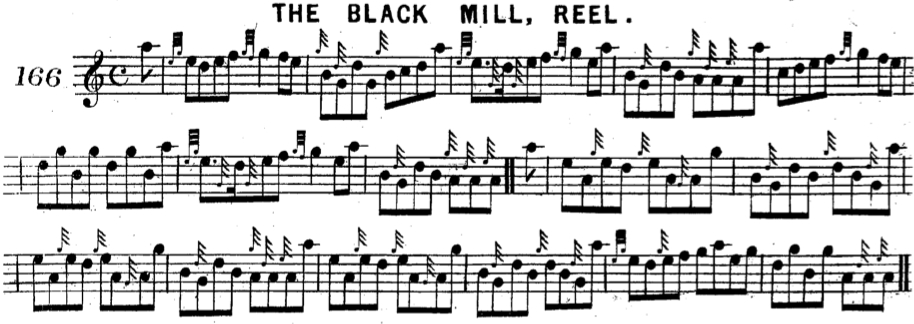By Alastair MacMillan
One of the features I enjoy reading on Bagpipe.news is the Stories of the Tunes series. One article that took my eye recently was the one about the reel, The Black Mill – or Muillean Dubh in Gaelic – a two-part reel that remains popular with pipers.
The author of the article, James E. Scott stated that many districts have claimed that the site of this mill was within their bounds but that none of them appear to have a better claim than Rothiemurchus.
I am not so sure about that. There are many “black mills” around the country and the mill referred to in the tune is actually in eastern Perthshire.
Kirkmichael is a tiny village located 12 miles east of Pitlochry on the A924 to Bridge of Cally. The first section of this road is known locally The High Drive, immortalised in the marvellous Gordon Duncan tune. It’s a beautiful area. I moved to Kirkmichael 12 years ago and on the outskirts of the village, at Tullochcurran, there is a former mill. This building lay derelict for many years before being renovated as their dwelling by a lovely couple, Mark and Sally McCallum.
The millwheel that was once turned by a lade that was fed yards away by the River Ardle is long gone. In the loft of the building, however, the old machinery is still intact.
The story behind the reel called The Black Mill is an old one and we have to thank the miller who lived here in 1571 for setting one traumatic experience that winter to music. We must also thank Charles Fergusson who told the story to the Gaelic Society of Inverness in 1895. The miller – his name remains unknown – also composed words for his tune which retell the story of the months of enforced idleness and hunger that resulted from the damage to the mill.
The gist of the story is that an enormous storm engulfed the wider district in 1571 causing widespread destruction and many deaths. Being a time of much superstition among the people, the blame was levelled on the “Great Hornie” – the devil – with a lesser role played by water kelpies, those shape-changing aquatic spirits of Scottish folklore.
As a result of the damage to the mill, the people of the district were starving for meal. The mill was repaired the following summer and on the first starting of it and its machinery the miller, who was also a bard, joyously composed the words and music.
Angus MacKay published the tune in his Piper’s Assistant book, but he, and others, mistakenly supposed that the title refers to black snuff mill which most Highlanders carried in their pocket. The English name that is often found in collections, The Black Snuff Mill, is quite an absurd mistake as the words clearly prove:

Tha ‘m Muilionn-dubh air bhogadan,
‘S e ‘togairt dol a dhannsa.
Bha cur ‘s cathadh ‘s gaoth,
Anns a’ Muilionn-dubh.
Shaoil learn gun robh min-eorna,
‘S a’ Muilionn-dubh, ‘a gun dean an.
Tha iorna rud nach saoill sibh,
‘S a’ Muilionn-dubh.
Tha ‘n Diabhuill-dubh air adhaircean,
‘S a’ Muilionn-dubh.
‘Ta ‘n crodh a breth nan laogh,
Anns a’ Muilionn-dubh, ‘s a’ Muilionn-dubh.
Tha gobhair, ‘s crodh-laogh,
‘S a’ Muilionn-dubh o Shamradh.
Tha nead na circe-fraoiche,
‘S a’ Muilionn-dubh.
Tha ‘m Muilionn-dubh air bhogadan,
Tha ‘m Muilionn-dubh air bhogadan,
Tha ‘m Muilionn-dubh air bhogadan,
‘S e ‘togairt dol a dhannsa.
I do not know the English translation.
From that day to the present, the mill at Tullochcurran, occasionally renewed, continued to grind good meal; and from that day to very near the present, it was always reckoned an uncanny place to go near after dark, being haunted by everything evil, more especially by the largest and most dangerous water kelpie on the Ardle, which haunted its mill-lade and croy when the Ardle was in flood.





